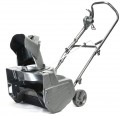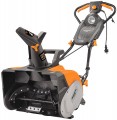Working width
The width of the strip of snow that the snow blower can clear in one pass. The larger the capture width, the fewer passes will be required to process the site, which is especially important on large areas. On the other hand, for processing small spaces, clearing individual paths, etc. significant width is not required (moreover, a “narrow” snow blower will pass more easily in a hard-to-reach place). The larger the capture width, the more powerful the engine, usually, ceteris paribus.
The most compact modern snow blowers have a working width of
less than 50 cm, these are mainly electric models of low power, although gasoline units are also found. A width of
50 – 60 cm can be called relatively small,
60 – 70 cm — medium, and in the largest models this figure
exceeds 70 cm.
Snow height
The maximum thickness of the snow layer that the snow blower removes in one pass. If you plan to regularly remove snow as it falls in a small area (for example, in the courtyard of your own private house), a grip height of up to 20 cm will be enough. If the opportunity to remove snow is rare (for example, in a country house where you visit only on weekends), you should pay attention to more powerful models with a height of about 50 cm.
Min. throw distance
The shortest distance that the snow blower can throw the collected snow.
The minimum range is indicated only for models with adjustable throw distance (see above). The meaning of this parameter is that in fact, long-range snow casting is not always desirable. For example, when clearing a path in the yard of a private house, snow often has to be poured literally next to the path, a little further — and it will fly onto the windows and walls of the house.
Note that the ejection range is a rather conditional value, because. snow (especially loose, freshly fallen snow) tends to dissipate in flight.
Max. throw distance
The maximum distance to which the snow blower can throw the collected snow (for models without throwing distance adjustment, the operating range itself). This value is rather arbitrary, since snow can be strongly dispersed in flight. Nevertheless, it characterizes the capabilities of the unit well and allows you to compare it with other models.
Long range is important mainly when working on large areas — it allows you to throw snow across the cultivated area so that it does not have to be collected a second time. As for specific figures, the value
up to 10 m is considered relatively small,
11 – 15 m — average, and in the most "long-range" models this figure can be
16 m or more.
Working mechanism
The type and material of the working mechanism, which is standardly installed in the snow blower.
—
Steel auger. An auger is a structure of several spirally curved plates that, due to rotation, ensure the movement of snow from the surface being cleared and throw it in the desired direction. Metal augers have high hardness and strength, due to which they are well suited for working with hard crust, dense compacted snow and high snowdrifts. On the other hand, such a tool can damage the coating under the snow, so such devices are poorly suited for work on paths with decorative coating. Also, a metal auger can break from a collision, say, with a stone, and therefore requires the use of safety systems (shear pins). Such augers are usually equipped with powerful self-propelled models, in which the working tool does not fit tightly to the ground.
—
Rubber auger. A type of auger (see above) made of rubberized material. Such augers are softer than steel ones, which means they can be used to clear paths with decorative coverings without fear of damaging the surface. At the same time, they are suitable for working only with loose, freshly fallen snow — such augers cope much worse with dense snowdrifts or crust than metal ones, and in this mode they quickly wear out and become unusable. Rubberized (or even solid rubber) augers are usually installed on non-self-propelled models, in which the tool can
...fit closely to the ground.
— Plastic auger. The advantages of plastic as a material for augers are low cost and good hardness, due to which such augers cope much better with frozen crust and compacted snow than rubberized ones. At the same time, they are much more careful with the road surface than metal ones, due to which they can be used almost close to the ground. At the same time, plastic is characterized by fragility and a tendency to crack when colliding with hard obstacles, and therefore this material is used relatively rarely and mainly in inexpensive snow blowers.
— Sweeper brush. A rotating cylindrical brush with long, rigid "bristles" fixed on a horizontal axis. This mechanism is designed to work with soft, loose snow of shallow depth. Its main advantage is the combination of cleanliness of processing and a good width of capture: the brush can provide a capture strip of 60-80 cm, leaving behind almost completely cleared soil. At the same time, it can be used on relatively "delicate" surfaces. But for high snowdrifts or densely packed snow, it is better to use augers.
— Steel auger/sweeper brush. In this case, the snow blower is equipped with both types of working mechanisms (see above for more details), and the operator can install the most suitable for the given conditions. This provides the greatest versatility: for example, you can remove the crust with a metal auger, and then install the brush and sweep the area clean.
— Blade. A device made of curved metal sheet for clearing snowdrifts. Allows for large volumes of work, used for clearing freshly fallen snow from access roads, parking lots, areas near garages or entrance gates to a private plot. To prevent damage to delicate road surfaces, a rubber coating is often “put on” the lower part of the blade. Based on the working situation, three fixed positions of the blade are usually assumed: vertically, with an inclination to the right or left.Auger / brush rotation speed
The speed of rotation of the working tool of the snow blower.
Other things being equal, a higher speed is good for performance, a lower speed gives more torque and improves efficiency in hard snow and crust. However, in fact, this parameter is more of a reference than practically significant: manufacturers select the speed in such a way as to ensure sufficient efficiency and productivity. In addition, many models are produced with several gears, where the rotation speed can be adjusted.
Design
—
Self-propelled design. In self-propelled snow blowers, the built-in motor drives not only the auger, but also the wheels / tracks, ensuring the movement of the device. In this way, you do not have to push the snow blower by hand, which makes work much easier — especially with heavy, powerful models. Most self-propelled models have a transmission that allows you to adjust the speed of movement, as well as the ability to move backward (see "Number of gears").
—
Overload protection. A safety system that protects the unit from breakdowns in the event of critical loads. The main reason for the occurrence of such loads is the jamming of the screw — for example, due to the ingress of a foreign object. Therefore, most often, special bolts are used for protection, connecting the auger to the motor gearbox: with a sharp increase in load, the bolts are cut off and the auger is disconnected from the gearbox. Another option is overheating protection that reacts to engine temperature; it is found predominantly in electrical assemblies and can be used alone or in combination with shear bolts.
—
Headlights. The presence of a headlight (headlights) in the design of the snow blower allows you to use it for work at night, when there are no other light sources or they are not enough. In addition, in some models, the headlights turn on automatically every time the engine is starte
...d — they play the role of a warning signal that the unit is running.
— Heated handles. Heating system for handles, which the operator holds during work. This feature is especially useful as snow blowers are used in cold weather, and hands can get cold during prolonged use. On the other hand, with small volumes of cleaning, you can completely do with gloves, so heated handles are found mainly in powerful models with internal combustion engines, designed for large volumes of work.Noise level
The average noise level produced by the snow blower during operation; the actual volume may differ slightly from this figure, but these deviations are usually negligible.
Note that snow blowers are quite loud equipment, plus the higher the power, the generally higher the noise level. This parameter is measured in decibels, this is a non-linear value, so the actual loudness is easiest to evaluate using comparative tables. So, the most "quiet" modern models give out about 55 – 60 dB — this can be compared with a conversation in slightly raised tones. 70 dB corresponds to a loud conversation, 80 dB to noise on a busy city street, 90 dB to a freight car at a distance of about 7 m, 100 dB to an industrial workshop, 110 dB to a tractor motor at a distance of 1 m.
The lower the noise level, the more comfortable this model will be to use. And according to sanitary standards, the maximum noise level considered safe for prolonged exposure (up to 8 hours) is 80 dB. So if the selected unit is noisier, and you plan to work often and for a long time, you should take care of protective headphones or earplugs.

